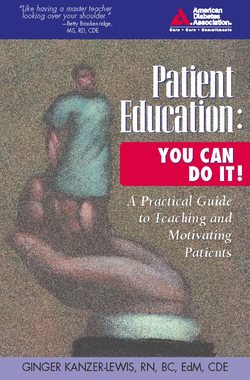Читать книгу Patient Education: You Can Do It! - Ginger Kanzer-Lewis - Страница 6
На сайте Литреса книга снята с продажи.
Foreword
ОглавлениеTEACHING: The earth doesn’t move every time, but when it does, what a RUSH!
—Cameron Beatty
I consider myself remarkably lucky to have found my calling in health education. I get such a thrill when someone’s face lights with insight. Or with determination. Or with pride and confidence. And that’s still the case after 25 years of teaching in diabetes. That one field has remained new and challenging to me for one reason and it is this: The job of fostering learning is more about the people I serve than about the facts and processes I teach. The latter could get boring and stale if it were not for the utter diversity and challenge of the former.
The fact that you are reading this book suggests that you already share that thrill with me. Or perhaps you are looking for ways to bring it to your teaching. In either case, you are in for a treat.
One of the many gifts my calling has brought into my life is Ginger Kanzer-Lewis. Ginger, like me and most other teachers in the health field, is largely self-taught. We know our profession, be it nursing, dietetics, or some other bailiwick of medicine. And we have some body of knowledge to impart, be it diabetes, cardiac, asthma, or optimal health. But most of us became teachers either by edict or by choice, not by training. The result is one that Ginger and I have talked about many times—frequent frustration over both the task and the outcome.
This book is Ginger’s offering to emerging and developing health facilitators. I know it is her hope that it will shorten the path from novice to technician to master, both for those entering the field and for those seeking further growth and skill.
Johnny: I taught my dog Spike to whistle.
Lucy: I don’t hear him whistling!
Johnny: I said I taught him. I didn’t say he learned!
And make no mistake. We need all the help we can get! One of the main challenges in my experience lies in making sure that our teaching actually fosters learning. Teaching, after all, is not the end in itself, but simply a means to an end. Teaching takes place in the teacher. Learning is happening in the learner. Sometimes the gap between the two is huge.
Like Johnny teaching Spike to whistle, health educators are often teaching from their own needs rather than helping the patient learn what is truly needed and helpful. In this book, you will find a wealth of practical advice to help you sort the wheat from the chaff as you decide what to teach and how. The ultimate answer is “what the patient wants to learn.” But there are techniques for engaging people and helping them find the meaning and importance of your message to them. Many of them are described in this book.
A good teacher is better than a spectacular teacher. Otherwise the teacher outshines the teachings.
—The Tao of Teaching
Learning is a lifetime task—or perhaps, more exactly, a lifetime privilege. Some have even suggested that ongoing learning is what makes a long life worth living. After all, those who learn keep a fresh outlook as they grow in skill and knowledge.
But the search for new knowledge and skills does not always grow out of choice. And that is the case with the people we serve as health educators. The need to learn or change has been thrust upon them by situations they would never have chosen: a heart attack, loss of hearing, worsening sight, or the diagnosis of a chronic condition such as asthma or diabetes.
Because of the reasons our patients come to us, we have a solemn obligation: to make sure that what we do makes a difference. As you read and practice the great tools presented here, keep in mind what your clients will say when you are done. Will it be, “He is a great teacher,” or will it be, “I learned so much”?
It is the teacher’s function to contrive conditions under which students learn.
—B.F. Skinner
I have had the privilege of watching Ginger teach a number of times over the years. And I always come away with new ideas to refresh my approach. I believe her genius lies in creating a rich environment for learning—one of relaxed fun, tinged with excitement, but always moving participants toward their own choices and growth. Much of her ease comes from experience and from utter familiarity with her subject. But part of it is technique as well. Scalpels do not make the surgeon, but she’d be up a creek without them.
In this book, she opens her toolbox to you. It is like having a master teacher looking over your shoulder. Enjoy!
Betty Brackenridge, MS, RD, CDE
Director, Professional Training
Diabetes Management & Training Centers, Inc.
Phoenix, Arizona
